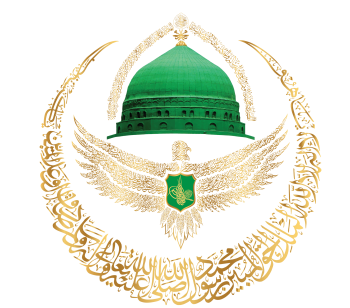First: The Quranic and Prophetic References to Movement in Dhikr
Quranic Reference to the Permissibility of Movement During Dhikr
It is mentioned in the Quran that movement during dhikr is permissible in the verse:
“Those who remember Allah standing, sitting, and lying on their sides…”【1】.
This Quranic text shows the permissibility of remembering Allah in different postures like standing, sitting, and lying, meaning that dhikr can be accompanied by both physical and spiritual movement, highlighting the flexibility of the method in which dhikr can be performed.
Allah also said:
“Do they not see what Allah has created of things whose shadows incline to the right and to the left, prostrating to Allah while they are humble?”【2】.
This verse indicates that everything follows a certain movement, like the shadows moving in different directions, and this movement signifies prostration and submission to Allah.
Prophetic Reference to the Permissibility of Movement in Dhikr
The Sunnah of the Prophet ﷺ confirms the permissibility of movement during dhikr. Imam Ahmad in his chain of narration and Al-Hafiz Al-Maqdisi narrated from Anas رضي الله عنه:
The Abyssinians were dancing in front of the Messenger of Allah ﷺ, saying: “Muhammad is a righteous servant.”
When the Prophet ﷺ saw them in this state, he did not forbid them, rather, he approved of it. It is known that Sharia rulings are derived from the sayings, actions, and approvals of the Prophet ﷺ, thus the movement during dhikr is permissible, as it helps stimulate the body and contributes to the presence of the heart with Allah.
The Opinion of Sufi Masters Regarding the Permissibility of Movement in Dhikr
- Shaykh Abu Ali al-Daqqaq: “Movement is a blessing; the movements of the outward cause blessings for the inner.”【5】
- Shaykh Abdul Rahman bin Abu Bakr al-Qadri: “What has no specific ruling and aligns with the principles of Sharia, we accept.”【6】
- Shaykh Abdul Wahhab al-Sharani: “Movement in dhikr is not forbidden, but it can be a means of reaching Allah.”
Second: The Importance and Benefits of Movement in Dhikr
Movement as a Cause for Presence
Shaykh Abu Bakr al-Hanbali said: “As for pausing in dhikr and movement within it, it is one of the reasons for presence.”【8】.
This means that movement helps the person performing dhikr to have their heart and senses present with Allah, thus enhancing the impact of dhikr on their soul.
To Expel Whispers and Negative Thoughts
Some of the early generations said: “The resolve in movement distracts the one remembering Allah from other negative thoughts.”
Movement during dhikr helps the disciple focus on the dhikr itself and prevents the intrusion of negative thoughts or whispers.
Distinguishing Good Traits from Bad Ones
Shaykh Jamaluddin Abdullah al-Bistami said: “Movement in dhikr distinguishes the good traits from the bad ones in the disciple.”
Movement represents a physical interaction that helps the disciple sort out their inner thoughts and determine what is good and beneficial.
Conveying the Effect of Dhikr to the Heart and Body
Some of the masters said: “The intense power in dhikr is what conveys the effect of Allah to the entire body.”【9】.
Movement helps to transmit the effect of dhikr throughout the body, allowing the dhikr to affect every cell in the body, making the person feel a spiritual closeness to Allah.
Activating the Body for the Remembrance of Allah
Movement contributes to activating the body, making dhikr more effective in stimulating both the soul and body to interact with dhikr and engage with spiritual energy.
Third: Movement in Dhikr in the Ksenazani Way
1. Movements Accompanying Daily Remembrances
These movements involve drawing the head from the lower diaphragm area and lifting it toward the right shoulder, then moving it to the left toward the heart.
These movements resemble the process of “hammering the rock,” symbolizing the purification of the heart and the cleansing of the soul from heedlessness.
2. Movements Accompanying Official Dhikr in the Ksenazani Lodges
These movements begin by repeating phrases such as: “Allah, I seek forgiveness from Allah, always seek forgiveness from Allah” while moving the head in the directions prescribed by the Sheikh.
These movements also include turning, bowing, and prostrating in the presence of Allah as a sign of humility and submission to Allah.
The Importance of Movements in Dhikr and Their Spiritual Benefits in Our Method
- Practical application of Allah’s words: “Those who remember Allah standing, sitting, and on their sides”【12】.
- Blessings for the entire body: The movement in dhikr, especially with the beats of the drum and tambourine, involves all the cells of the body in dhikr, enlightening them with the light of Allah’s remembrance.
- Humility and submission to Allah: Movement represents a surrender of arrogance and pride, where the person removes all worldly desires in complete submission to Allah.
- Achieving spiritual benefits: Since dhikr purifies the heart, the movements associated with dhikr raise the soul to higher levels and contribute to spiritual elevation.
Conclusion
Movement in dhikr is considered an essential part of the Ksenazani method. It is not just a physical movement but a deep spiritual interaction that strengthens the connection with Allah. Movement helps the person performing dhikr to fully interact with the remembrance, leading to the purification of the soul and preparing it to receive the light of Allah.

